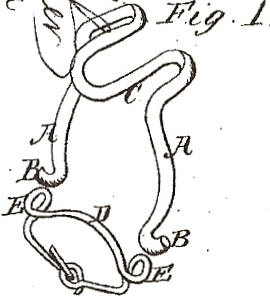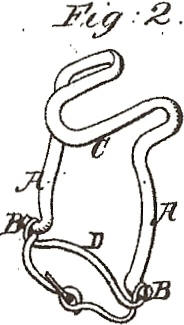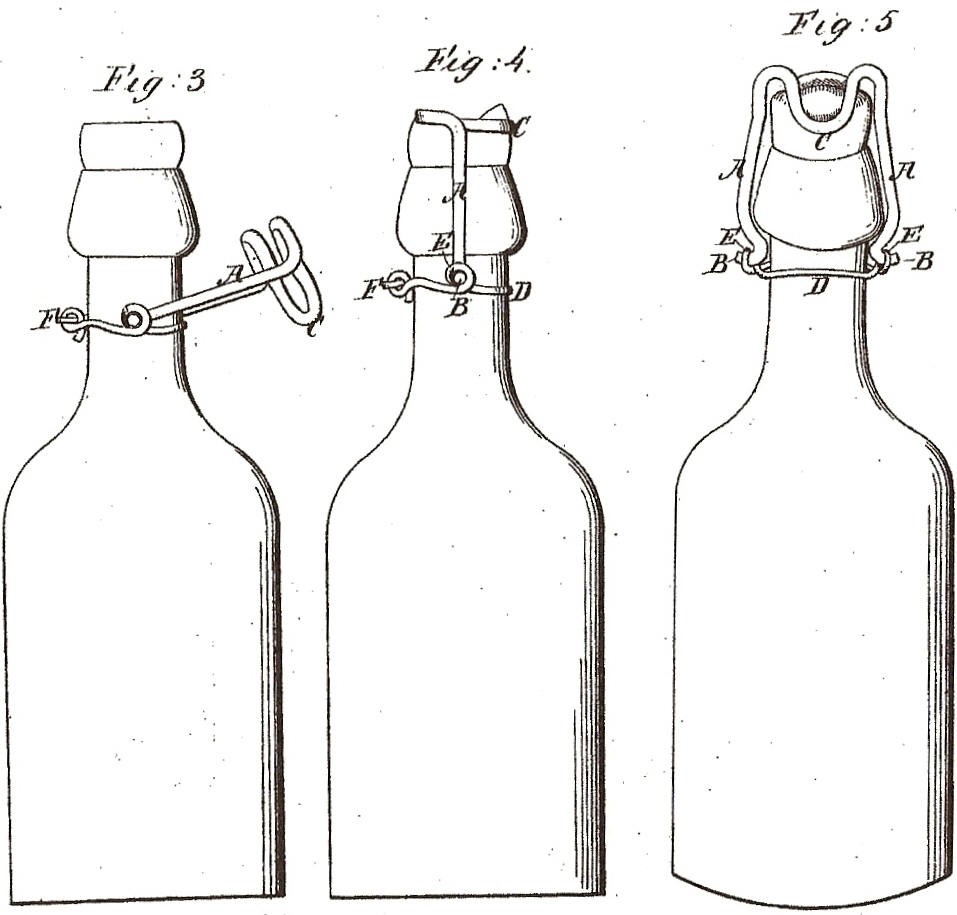Henry W. Putnam Stopper Fastening
U. S. Patent Number: 1,606 (Reissue) Patented: January 19, 1864



Henry W.
Putnam’s patent application specified:
I, Henry W. Putnam, of…
Fastenings for bottles have heretofore been made in
which a strap of metal has extended over the cork from a hinge or joint
formed on each side of the neck of the bottle by a second metallic
strip. This device is costly
to manufacture, and is liable to be displaced in use by the pressure
upon the cork, because such metal strap has had a notch formed therein
for the plunger, (that holds in said cork after the bottle has been
filled,) which notch allows the cork to project at this point, and by
springing up the metal on the sides of the notch form an inclined plane,
against which the pressure acts to force the fastener aside and relieve
the cork.
The nature of my said invention consists in forming
the fastener of wire bent in such a manner that if the pressure upon the
cork is sufficient to bend said wire fastener it will retain the cork
more firmly and the cork require to be pushed in before the fastener can
be pushed aside, thus causing the pressure to render the fastening more
secure instead of more liable to failure.
I also form joints for securing the fastener and forming a hinge
upon which it may be turned aside by bending the ends of such wires at
right angles, or nearly so, to the sides of the fastener, and I make use
of a wire for attaching this fastener to the bottle, in which the eyes
are formed for receiving the ends of the fastener, and on which the said
fastener swings, thus producing by one piece of wire a much more simple,
effective, and cheap attachment than any before made.
In the accompanying drawings, Figure 1 represents the
fastener with the two parts separated from each other.
Fig. 2 represents the fastener with the two parts united.
Fig. 3 represents the fastener with one part loosely inclosing
the neck of the bottle, and Figs. 4 and 5 show different views of the
fastener in use…
The bottles are filled under a pressure of two or
three atmospheres for the purpose of holding the carbonic-acid gas in
solution with which the liquid is charged…
The manner of using this fastening is as follows: The
bottle is placed under the fountain and its neck encircled at the top by
the tube that conveys the saturated water or other liquid into the
bottle. The cork being
placed in the tube above the side pipe that admits the fluid into the
bottle, by turning a stop-cock the bottle becomes filled with the
liquid, and by means of the piston above the cork the cork is forced
into the neck of the bottle, the fastening being turned aside, as seen
in Fig. 3. When the bottle
is full and the cork inserted, the pipe is elevated, the piston still
holding the cork. The
fastener is then forced over the end of the cork, as seen in Figs. 4 and
5, in which position it is held from being pressed out by the expansion
of the gas…It is sometimes necessary to force in the cork before the
fastener can be released, which is effected by pressing with the thumb
on the sides A of the wire fastening and turning it off into the position of Fig.
3.
Comments:
This summary includes the illustrations accompanying
the original 1859 patent filing, plus selected portions of the 1864
patent reissue specifications.
Putnam’s fastener clearly illustrates one of the most popular
methods used to hold externally inserted corks into blob top soda
bottles. Looping a wire over
the cork and twisting it around the neck beneath the blob top was also
quite common. Blob top soda
bottles are sometimes incorrectly identified as
 HutchBook.com
HutchBook.com